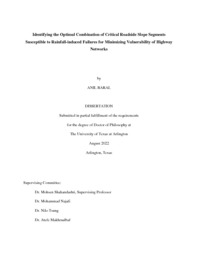
ATTENTION: The works hosted here are being migrated to a new repository that will consolidate resources, improve discoverability, and better show UTA's research impact on the global community. We will update authors as the migration progresses. Please see MavMatrix for more information.
Show simple item record
| dc.contributor.advisor | Shahandashti, Mohsen | |
| dc.creator | Baral, Anil | |
| dc.date.accessioned | 2022-09-15T12:07:13Z | |
| dc.date.available | 2022-09-15T12:07:13Z | |
| dc.date.created | 2022-08 | |
| dc.date.issued | 2022-08-11 | |
| dc.date.submitted | August 2022 | |
| dc.identifier.uri | http://hdl.handle.net/10106/30932 | |
| dc.description.abstract | The stability of roadside slopes is vital for the smooth operation of the highway transportation system. The failure of slopes adjacent to the highway corridors adversely impacts the network users and network operators. The network users are subjected to delays through speed restrictions, stoppage, and diversions due to the blockage of a motorway. The network operators face the burden of implementation and finance of emergency slope repairs. Proactive rehabilitation of slopes helps to reduce roadside slope failures and minimize the disruption of transportation networks resulting from rainfall-induced slope failures. However, all the slope segments susceptible to rainfall-induced failures cannot be rehabilitated at once due to the limited availability of rehabilitation resources in federal and state transportation agencies. This research aims to develop an approach to identify the optimal combination of slope segments that should be proactively rehabilitated to reduce the vulnerability of transportation networks when only limited slope segments can be rehabilitated. To achieve the objective, first, a combination of a physically-based slope stability model and a hydrological model was used to determine the location of all slopes that are susceptible to rainfall-induced slope failures. Then, a stochastic combinatorial optimization problem was formulated with an objective function that measured the impact on the road users and transportation agencies (i.e., network operators) for different slope failure scenarios. The combinatorial optimization problem was solved using the genetic algorithm-based approach to provide the most suitable combination of slope segments that should be proactively rehabilitated for minimizing the impacts on the road user and transportation agencies following rainfall-induced instabilities. The decision-making approach for slope rehabilitation should also ensure low risk associated with the selected rehabilitation strategy. However, current slope-rehabilitation decision models do not consider the risk (i.e., distribution of failure cost) associated with the rehabilitation strategies in the decision-making process. Therefore, a risk-averse stochastic combinatorial optimization problem was further formulated and solved using a simulated annealing technique to facilitate the selection of slope rehabilitation strategies, which leads to the least expected cost and conditional value at risk (CVaR) for extreme rainfall events.
The proposed approach to identify the optimal combination of critical slope segments was implemented in the transportation network of Lamar County, Texas. The proposed metaheuristic-based approaches outperformed the commonly used index-based methods in the literature for identifying the critical roadside slopes susceptible to rainfall-induced failures. The risk-averse simulated annealing approach also provided a range of solutions in the Pareto-efficient frontier enabling the transportation agencies to select the rehabilitation combination with different risk aversion levels.
The primary contribution of this research work to the body of knowledge is the development of metaheuristic optimization approaches to facilitate the identification of the critical combination of slope segments for proactive repair, with consideration of slope failure probabilities, slope failure cost, and risk aversion levels in rehabilitation decision-making. More importantly, the proposed rehabilitation approaches will aid transportation agencies in making an optimal allocation of the limited rehabilitation budget to improve the performance of clayey soil slopes that are susceptible to rainfall-induced shallow failures. | |
| dc.format.mimetype | application/pdf | |
| dc.language.iso | en_US | |
| dc.subject | Slope failure | |
| dc.subject | Rehabilitation | |
| dc.subject | Genetic algorithm | |
| dc.subject | Simulated annealing | |
| dc.subject | Value at risk | |
| dc.title | Identifying the Optimal Combination of Critical Roadside Slope Segments Susceptible to Rainfall-induced Failures for Minimizing Vulnerability of Highway Networks | |
| dc.type | Thesis | |
| dc.degree.department | Civil Engineering | |
| dc.degree.name | Doctor of Philosophy in Civil Engineering | |
| dc.date.updated | 2022-09-15T12:07:14Z | |
| thesis.degree.department | Civil Engineering | |
| thesis.degree.grantor | The University of Texas at Arlington | |
| thesis.degree.level | Doctoral | |
| thesis.degree.name | Doctor of Philosophy in Civil Engineering | |
| dc.type.material | text | |
| dc.creator.orcid | 0000-0002-4026-3986 | |
Files in this item
- Name:
- BARAL-DISSERTATION-2022.pdf
- Size:
- 3.009Mb
- Format:
- PDF
This item appears in the following Collection(s)
Show simple item record


